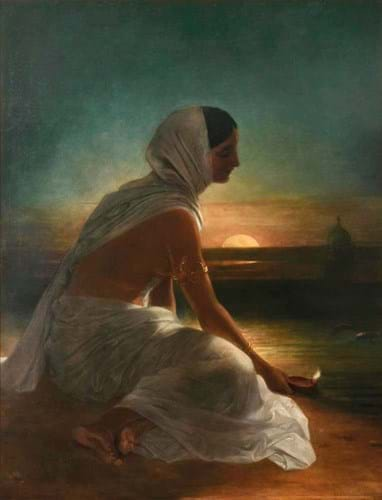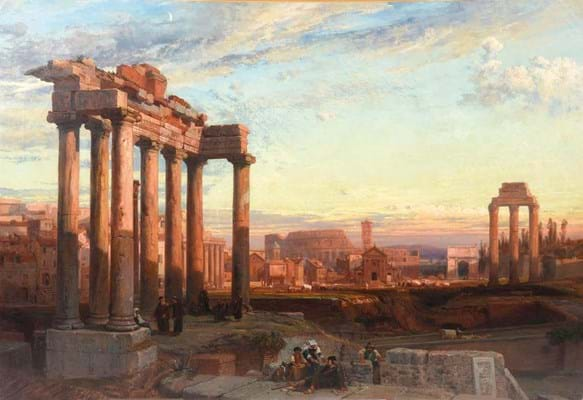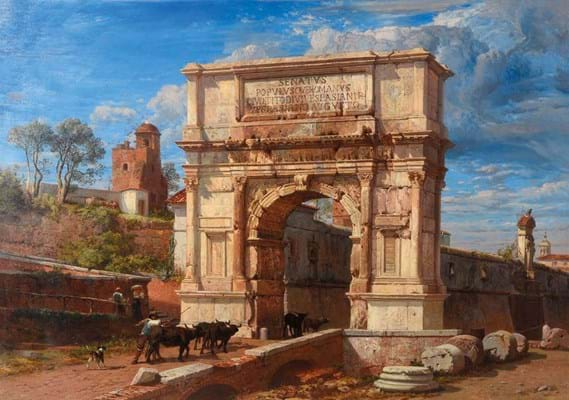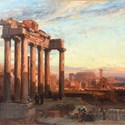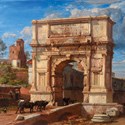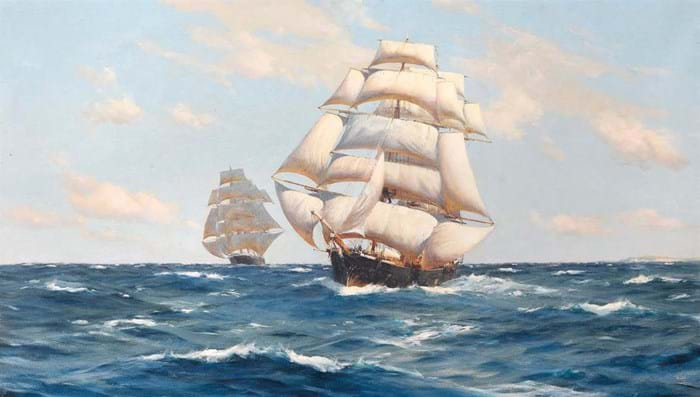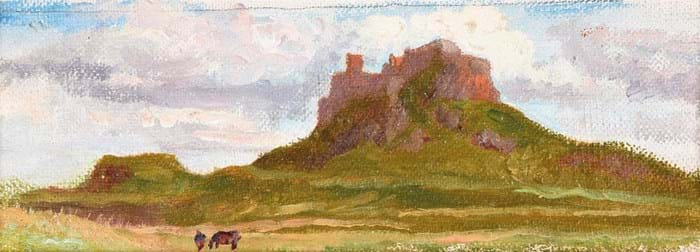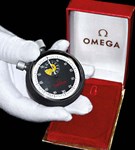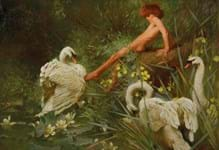While major sums in recent weeks were posted by 20th century artists such as Alfred Munnings (£105,000 at Gildings) and Algernon Newton (£225,000 at Duke’s), the good run continued into the middle and end of May with sales of two 19th century paintings for six-figure sums in Edinburgh and Newbury.
John William Godward’s (1861- 1922) sumptuous 1898 oil on canvas Poppies came to the Lyon & Turnbull (25/20% buyer’s premium) Five Centuries sale from the estate of Dr Helen EC Cargill Thompson (1933-2020).
She was a public-spirited Glaswegian who donated her collection of Contemporary art to Strathclyde University and her silver collection to The Glasgow School of Art – and proceeds from the sale of this trademark aesthetic picture were pledged to Strathclyde.
Cargill Thompson had owned the painting for many years. Signed and dated ’98, the 2ft 6in x 2ft (76 x 61cm) oil on canvas was painted by Godward – the ‘High Victorian Dreamer’ – at the peak of his powers.
It depicted the model Ethel Warwick (16 when she posed for this picture) in classical attire against a meticulously painted backdrop of lavender and red poppies.
The subject and style was typical of Godward’s output. He painted numerous works of reclining women in classical settings and, while they may have represented a Victorian visual fantasy, he made great efforts to ensure the details of the architecture and costume were historically accurate. This was a mid-size work by the artist’s standards but it had substantial commercial potential thanks to its technical qualities such as the elegant textures to the marble, fabrics and flesh, as well as the luxuriant composition.
Estimated at £100,000-150,000 at the sale in Edinburgh on May 20, it attracted international bidding and was sold at £360,000. With premium added, the price was £447,000.
L&T picture specialist Nick Curnow said: “It is an exquisite painting and has been much admired since it initially came in for sale. In very good condition, we are pleased it has found a new home with a UK-based private buyer.”
The auction record for Godward stands at £900,000 for Far Away Thoughts sold at Christie’s in December 2012, but this appears to be the highest price for the artist at a UK sale outside London other than the £440,000 for the rediscovered A Cool Retreat II, another work showing a reclining classical maiden, that sold at Gorringe’s in Lewes in March 2005. The price at L&T was also the top result for a picture sold outside London so far this year.
Daniell in demand
Meanwhile, strong interest for 19th century works also boosted the latest auction of Old Master, British and European Art at Newbury saleroom Dreweatts (25% buyer’s premium).
The May 27 sale offered a depiction of a young woman performing a ritual on the moonlit banks of the Ganges river by English artist William Daniell (1767-1837).
Indian scenes are Daniell’s most famous and commercial works and have made strong six-figure prices at auction on around 10 occasions.
Born in Kingston upon Thames, Surrey, Daniell became an assistant to his uncle, the landscape painter Thomas Daniell (1749-1840), following the early death of his father. Aged 16, he accompanied his uncle to India to work on producing a series of prints. He remained there for 10 years until returning to England in 1794.
The sets of aquatints they produced on their return, published as a volume titled Oriental Scenery, were a great success as the British public lapped up the atmospheric views of scenery and architecture.
Although copies of the prints appear fairly often at auctions today, original drawings and sketches are rarer and larger and fully completed oil paintings (usually produced later and based on his drawings) are rarer still and highly prized.
The 4ft 7in x 3ft 7in (1.4 x 1.08m) oil on canvas at Dreweatts was a large and moody picture. It was exhibited at the Royal Academy in 1837, titled The Hindoo Girl’s Offering, and came to auction from a UK private collector.
The subject was particularly appealing to bidders. Showing a scene from the Karva Chauth festival, the young woman is pictured lighting a small earthenware lamp and casting it off to the water. According to the Royal Academy listing, the women were ‘convinced if the lamps continue to burn until they fade into the distance, that their absent lovers would remain constant; on the contrary, should they become extinguished, it is held to be an augury of calamity’.
Estimated at £10,000-15,000, Dreweatts reported that the painting attracted worldwide interest and it was eventually knocked down at £110,000. The sum was the highest price for the artist since Christie’s offered three fine topographical works in December 2016, where one example made £400,000 and two fetched £120,000 apiece, and also just scraped into the top 10 prices for the artist (source: Artprice by Artmarket).
In any case, the result provided a decent contribution to Dreweatts’ overall £1.28m total (including buyer’s premium) with 72% of the 384 lots sold.
Joint head of Dreweatts picture department Brandon Lindberg said: “It was very encouraging to see so many bidders but, having handled British 19th century art for over two decades, I know how strong the market can be for great images, with good provenance, that are fresh to the market and well-priced.”
Lindberg pointed out that the 70 pictures from the Berwick House collection at the sale, which included some notable Victorian works, had not been on the market for 150 years and drew a good response “even for works that were not necessarily by the most important artists of the period”.
“I think this area still represents tremendous value for money and collectors are coming to realise that,” he added.
Bridell’s Rome
Furniture from this Shropshire estate was sold by Dreweatts earlier in May. On May 27 two views of the ruins of ancient Rome by Frederick Lee Bridell (1831-63) caught the eye in particular.
They had been in Berwick House since the 1870s when the property was acquired by shipbroker and merchant James Watson. The paintings, both signed oils on canvases from 1862, were bought from London dealer Arthur Tooth and Sons.
Almost identically sized at approximately 2ft 10in x 4ft 1in (88cm x 1.24m), one depicted The Arch of Titus at Rome looking towards the capital and the other showed The Temple of Saturn, the Forum and the Colosseum beyond.
The works dated from Bridell’s spell in Italy in 1858-62, a period deemed the most successful and productive of his short career (like his mentor Richard Parkes Bonnington, he died young of tuberculosis).
They demonstrated the way the artist vividly captured the sense of the classical past but also the everyday lives of shepherds, herdsman and townspeople going about their work.
Both works were estimated at £20,000-30,000 at Dreweatts. Selling to different UK buyers, The Arch of Titus… took £31,000 and The Temple of Saturn… made £30,000.
Apart from a view of Lake Como from 1861 that sold for €42,000 (£37,660) at Pandolfini Casa d’Aste in Italy in December 2009, these were the highest prices for the artist at auction (source: Artprice by Artmarket).
Another lot from the Berwick House collection bringing demand was Tea Clippers Racing Up Channel by Thomas Jacques Somerscales (1842-1927). The 23in x 3ft 6in (59cm x 1.06m) signed oil on canvas from 1906 was a vintage example of his English sailing pictures and it came fresh to the market having again been in Berwick House for over a century.
Interestingly, the Yorkshire-born artist retains a large following in Chile after spending almost 30 years in the country painting local landscapes and marine scenes relating to Chilean naval history.
Estimated at £6000-8000, this example of his work sold at £35,000 to an international collector.
Elsewhere, the expected highlight from a group of nine pictures that came directly from the family of the artist Samuel Pepys Cockerell (1844-1921) failed to get away on the day. This was a portrait of Cockerell himself by George Frederic Watts estimated at £30,000-50,000.
Instead, the top-selling lot from the consignment was one of three small oil sketches by Cockerell’s friend and mentor Frederic, Lord Leighton (1830-96) depicting the 16th-century Lindisfarne Castle in Holy Island, Northumberland, at different times of the day.
This example, a 2 x 6in (6 x 16cm) oil on canvas laid down on board, included a horse and rider in the foreground and was estimated at £2500-3500. It sold at £10,000 to a UK collector who also secured another Lindisfarne view at £8000.
The third Lindisfarne picture was unsold at the auction but sold afterwards for £5500 to another collector.



